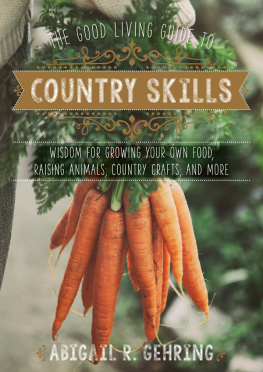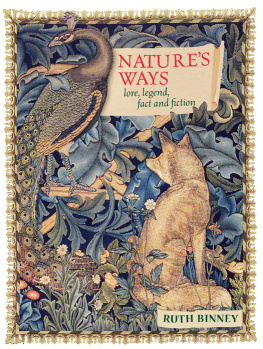
JERRY MACK JOHNSON

First published in 2011 by
Voyageur Press, an imprint of
MBI Publishing Company,
400 First Avenue North, Suite 300,
Minneapolis, MN 55401 USA
Text copyright 2011 by Jerry Mack Johnson
Text originally published in Country Wisdom (1974), Country Scrapbook (1977), and Down Home Ways (1978).
All rights reserved. With the exception of quoting brief passages for the purposes of review, no part of this publication may be reproduced without prior written permission from the Publisher.
IMPORTANT, PLEASE READ:
Any recipes or health cures are intended as a historical reference only. They are NOT recommended by the editors or publisher of this book. They have been compiled as a historical narrative for historical purposes only.
The publisher assumes no responsibility whatsoever for any injury or damage resulting from readers use of any of the material or information contained in this book.
We recognize, further, that some words, model names, and designations mentioned herein are the property of the trademark holder. We use them for identification purposes only. This is not an official publication.
Voyageur Press titles are also available at discounts in bulk quantity for industrial or sales-promotional use.
For details write to Special Sales Manager at MBI Publishing Company, 400 First Avenue North, Suite 300, Minneapolis, MN 55401 USA.
To find out more about our books, visit us online at www.voyageurpress.com.
ISBN-13: 978-0-7603-4001-1
Digital edition: 978-1-6106-0251-8
Softcover edition: 978-0-7603-4001-1
Editor: Margret Aldrich
Design Manager: LeAnn Kuhlmann
Designed by: Rick Korab, Korab Company Design
Cover designed by: Matthew Simmons

Image CreditsImages are from the Voyageur Press Archive and the following sources: Clipart.com: 185 (bottom); Florida Center for Instructional Technology: 86, 96, 116, 117, 170 (top right), 173, 185 (top), 186 (top), 188, 189, 190, 192, 193, 197, 208, 243, 269, 339 (left), 340; Graphic Ornaments by The Pepin Press: 68 (banner), 9 (banner), 153, 167 (banner), 259 (banner), 260269 (banner), 339352 (banner); Library of Congress: 45, 47, 48, 256 (bottom left); Shutterstock: 111 (top right); Eric Sloane: 2.
Printed in China
Preface
Maple leaves stained gold and crimson, sent by friends from the Northeast, brightened our home. A visitor, unaccustomed to leaves of such vivid hues here in West Texas, remarked on their beautyadding, however: I dont know what kind they are, but as far as Im concerned, leaves are just leaves. That commentary set me to recalling the varied roles leaves had played in my boyhood, valid evidence that leaves were more than just leaves.
At the first signs of spring, shoes were kicked aside, and boys ran barefoot. By midsummer, quite a callused pad had built up on the bottoms of our feet. The roughest terrain of stones, stubble, or even nettles scarcely caused us to wince, so protected were we by our leathery soles. But feet at summers start were tender, having been pampered through the winter months by such civilized gear as socks and boots or brogans. As a consequence, many a foot suffered from bruising. Grandfather had a sure-fire remedy for this. He gathered Madeira vine and bound the mashed leaves around each stone bruise. By next morning Id be off and running, the cure complete.
We didnt have bottled air fresheners in those days; instead, they sprang from the ground. I remember Mother picking mint sprigs from around an old water spigot, drying them, and crumbling their brittle leaves into small china pots, placed strategically throughout the house.
I accepted as fact that Nature could satisfy almost any need, if we but had the knowledge of her secrets. My elders appeared to exhibit an unending supply of that vital knowledge with their ability to heal with herbs, to predict weather and animal behavior, and to locate underground water with a forked twig.
Such reminiscences of my country boyhood led to others: my string of pets. While city boys might cherish their pedigreed dogs, my pets came to me from the surrounding fields and rangewithout credentials as to genteel genealogy, but each winning my affection in its own unique way. I wondered how many folks had a firsthand acquaintance with possums, armadillos, and other small country creatures. (Not all animals are to be recommended as pets, however, as my interesting and odoriferous possum soon proved when he sank his needle-sharp teeth through my hand.)
Pets werent our only diversion. Outings to medicine shows, tent circuses, Wild West shows and rodeos, horse races, brush-arbor camp-meeting preachings, and the simple but enjoyable games we indulged in after school were deeply satisfying forms of entertainment.
I cant forget the way our house gleamed, despite the lack of todays highly touted cleansers. Homemade soap and plenty of elbow grease kept both clothes and home sparkling.
Many an old recipe handed down from before Grandmas time was responsible for the tantalizing smells that permeated our kitchen.
My friends observation that leaves are just leaves sparked the thought that perhaps we need to be reminded of the bounty of Natures offerings. Her riches are all around us; yet so often they are taken for granted. With such feelings and memories in mind, I wrote this volume as a means of sharing them with others. And so maple leaves, not the Muses, inspired this book.




Over the ages, country people developed an oral catalogue of weather wisdom through their observation of weather patterns, atmospheric conditions, and their consequences on living creatures and inanimate objects. Each generation handed down its accumulated knowledge to the next, new information being added with the years. Such knowledge, both inherited and gleaned from experience, was relied upon in daily life by farmers, cattlemen, sheepherders, and navigators. Gradually, oft-noted weather sequences and their effects became incorporated into sayings, frequently based on dependable lore but sometimes solely on superstition.
At times it is nice to have advance knowledge of what Mother Nature has in mind for tomorrows weather. By reading her weather signs you can become a fairly reliable weather forecaster.
What follows is a gathering of many of natures weathers signs that have been handed down for many generations. These signs were learned on the range, prairie, mountains, and sea. We have gathered them over many years and many miles.



















